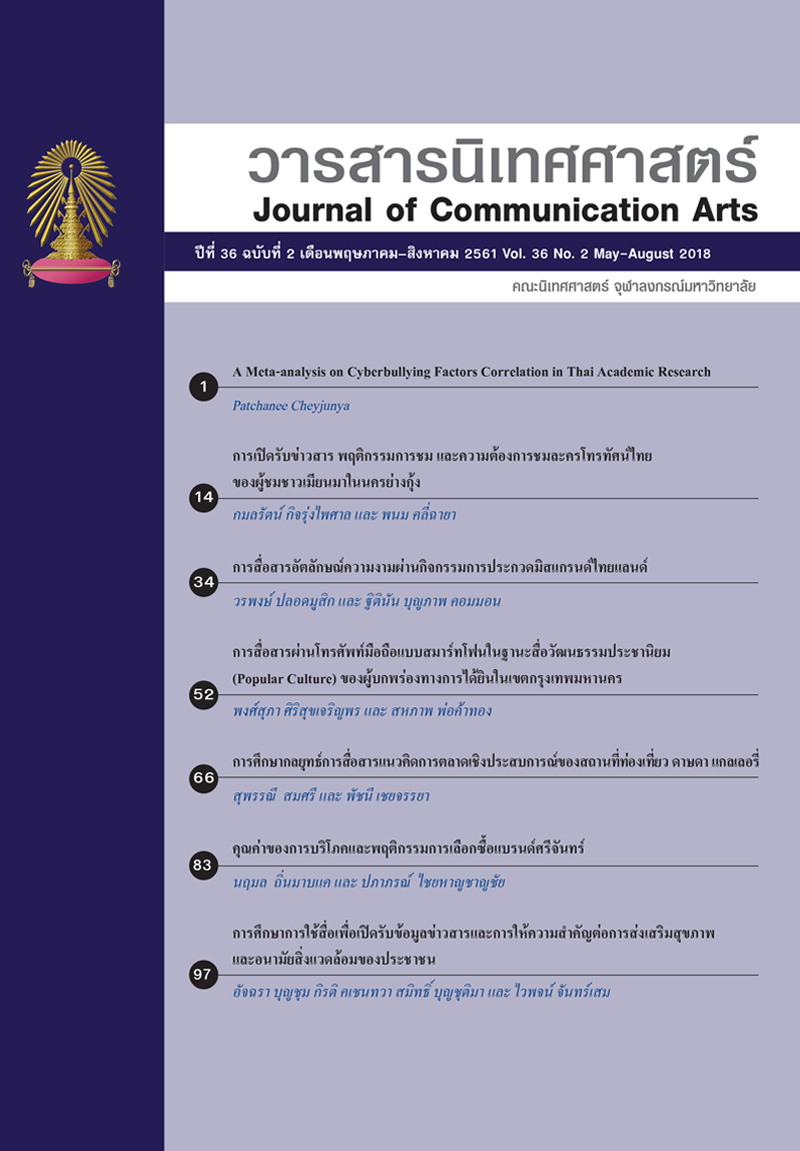Consumption Value and Consumer Choice Behavior of Srichand
Main Article Content
Abstract
The purpose of this research was to study consumption value and choice behavior of Srichand.A quantitative research was conducted through a survey research method. Data were collected through self-reported questionnaire with 200 female consumers, aged between 20 and 40 years old, in Bangkok. The results showed that functional and emotional value of Srichand were the highest perceived value (M = 4.12). In terms of functional value, the sampling mostly agreed that the price of Srichand’s products were reasonable (M = 4.20), and Srichand’s products were safe (M = 4.19). In terms of emotional value, the sampling mostly agreed that buying Srichand’s products made them feel that they support a Thai brand (M = 4.19). On the other hand, social value was the least perceived value (M = 3.63). That is, using Srichand’s product made them get social approval (M = 3.60). In addition, for choice behavior, the results indicated that the sampling were more likely to buy products made out of natural, not chemical ingredients (M = 4.25). This research results also reflected a relationship between consumption value and consumer choice behavior.
Article Details
References
ฐนิตา ตู้จินดา. (2558). ปัจจัยที่มีผลต่อการตัดสินใจเลือกซื้อเครื่องสำอางนำเข้าจากประเทศกลุ่ม อาเซียนของนักศึกษามหาวิทยาลัยบูรพา. การค้นคว้าอิสระปริญญามหาบัณฑิต,มหาวิทยาลัยบูรพา.
ธนา ตันติเอมอร. (2558). พฤติกรรมการตัดสินใจซื้อเครื่องสําอางนําเข้าจากต่างประเทศ ของประชากรใน จังหวัดปทุมธานี. การค้นคว้าอิสระปริญญามหาบัณฑิต, มหาวิทยาลัยเทคโนโลยรีาชมงคลธัญบุรี.
ปัทมพร คัมภีระ. (2558). พฤติกรรมการซื้อเครื่องสําอางผ่านเว็บไซต์เฟซบุ๊ค ของนักศึกษาหญิงในเขต กรุงเทพมหานคร. การค้นคว้าอิสระปริญญามหาบัณฑิต,มหาวิทยาลัยกรุงเทพ.
ร้านอาหารในไทยคว้าแชมป์โลกเป็นปีที่ 2. (2557). สืบค้นจาก https://www.posttoday.com/market/
news/418875.
รายงานสถิติสินค้านำเข้าของกรมศุลกากร.(2559).สืบค้นจาก http://www.customs.go.th/statistic_
report.php?ini_content=statistics_report&lang=th&left_menu=nmenu_esevice_007.
ศรีจันทร์. (2559). สืบค้นจาก https://www.srichand.com/th/pages/about_us.
มหาดไทยขอบคุณคนไทยช่วยอุดหนุนสินค้าไทยในงาน“OTOP Midyear 2017” 8 วัน เงินสะพัดสู่เศรษฐกิจชุมชน 857 ล้านบาท. (2560). สืบค้นจาก http://www.thaigov.go.th/news/contents/
details/4094.
Aaker. (1996). Building strong brand. New York: Free.
Aaker, D.A. & Joachimsthaler, E. (1999). Brand leadership. New York: Free.
Ajzen, I. (1991). The theory of planned behavior. Organizational Behavior and Human Decision Processes,50(2), 179 - 211.
Bei, L., Simpson, E. (1995).The determinants of consumers’ purchase decisions for recycled products: an application of acquisition-transaction utility theory. Advances in Consumer Research,22(1), 257 - 261.
Comrey, A. L., & Lee, H. B. (1992). A First Course in Factor Analysis (2nd ed.). Hillsdale, NJ: Lawrence Erlbaum.
Gimpel, J. (2011). Our patchwork nation: The surprising truth about the “real” America. New York: Gotham.
Hair, J. F., Black. W. C., Babin. B. J., & Anderson. R. E. (2010), Multivariate data analysis, (7th ed.). New Jersey: Pearson Prentice Hall.
Hart, S. & Murphy, J. (1998). Brands: The new wealth creators. London: Macmillan.
Hawkins, D. I., Best R. J., & Coney, K. A. (2004). Consumer behavior: Building marketing strategy (9th ed.). New York: Mc Graw-Hill.
Hyman, H. H. (1942) The psychology of status. arch. psychol. Innovations (2nd ed.). New York: Routledge.
Keller, K. L. (2003). Strategic brand management. New Jersey: Pearson Education.
Kotler, P. (1991). Marketing management (8th ed.). Englewood Cliffs, New Jersey:PrenticeHall.
Lambkin, M., & Muzellec, L. (2008) Rebranding in the banking industry following mergers and acquisitions. International Journal ofBank Marketing, 26(5). 328 -352.
Lin, P., & Huang, Y. (2011). The influence factors on choice behavior regarding green products based on the theory of consumption values. Journal of Cleaner Production, 22(1), 11–18.
Mowen, J. C., & Minor, M. (1998). Consumer behavior (5th ed.). New Jersey: Prentice- Hall.
Pavlou, P.A., & Chai, L. (2002). What drives electronic commerce across cultures? a cross-cultural empirical investigation of the Theory of Planned Behaviour. Journal of Electronic Commerce Research, 3(4), 240-253.
Ramkissoon, H., Nunkoo, R., & Gursoy, G. (2009). How consumption values affect destination image formation, in Woodside, A.G., Megehee,River, New Jersey: Pearson Education.
Robertson, T. S. (1962). The Process of Innovation and the Diffusion of Innovation. J. Marketing, 31(1-7), 14-19.
Rogers, E. M., (1962). Diffusion of znnovations. New York: The Free Press of Glencoe.
Schiffman, L. G., & Kanuk, L. L. (2010). Consumer behavior (10th ed.). New Jersey: Prentice-Hall.
Schultz, D. (2004). Understanding the Diffusionof Integrated Marketing Communications.Journal of Advertising Research,44(1), 31-45.
Sheth, J., Newman, B., & Gross, B. (1991). Why we buy what we buy: a theory of consumption values. Journal of Business Research, 22(2), 159-170.
Solomom, M. R. (2015). Consumer behavior: Buying, having, and being (11th ed.). Upper Saddle River, NJ: Pearson.
Yeonsoo, L., Jinwoo, K., Inseong, L., & Hoyong, K. (2002). A cross-cultural study on the value structure of mobile internet usages: comparison between Korea and Japan. Journal of Electronic Commerce Research, 3(4), 227-239.


